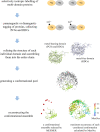Characterizing conformational ensembles of multi-domain proteins using anisotropic paramagnetic NMR restraints
- PMID: 35340613
- PMCID: PMC8921464
- DOI: 10.1007/s12551-021-00916-4
Characterizing conformational ensembles of multi-domain proteins using anisotropic paramagnetic NMR restraints
Abstract
It has been over two decades since paramagnetic NMR started to form part of the essential techniques for structural analysis of proteins under physiological conditions. Paramagnetic NMR has significantly expanded our understanding of the inherent flexibility of proteins, in particular, those that are formed by combinations of two or more domains. Here, we present a brief overview of techniques to characterize conformational ensembles of such multi-domain proteins using paramagnetic NMR restraints produced through anisotropic metals, with a focus on the basics of anisotropic paramagnetic effects, the general procedures of conformational ensemble reconstruction, and some representative reweighting approaches.
Keywords: Ensemble reconstruction; Multi-domain proteins; Nuclear magnetic resonance; Pseudocontact shifts; Residual dipolar couplings.
© International Union for Pure and Applied Biophysics (IUPAB) and Springer-Verlag GmbH Germany, part of Springer Nature 2021.
Conflict of interest statement
Conflict of interestThe authors declare no competing interests.
Figures



Similar articles
-
Using Pseudocontact Shifts and Residual Dipolar Couplings as Exact NMR Restraints for the Determination of Protein Structural Ensembles.Biochemistry. 2015 Dec 29;54(51):7470-6. doi: 10.1021/acs.biochem.5b01138. Epub 2015 Dec 17. Biochemistry. 2015. PMID: 26624789
-
Molecular Dynamics Simulations Combined with Nuclear Magnetic Resonance and/or Small-Angle X-ray Scattering Data for Characterizing Intrinsically Disordered Protein Conformational Ensembles.J Chem Inf Model. 2019 May 28;59(5):1743-1758. doi: 10.1021/acs.jcim.8b00928. Epub 2019 Mar 18. J Chem Inf Model. 2019. PMID: 30840442 Review.
-
Structure determination of protein-protein complexes with long-range anisotropic paramagnetic NMR restraints.Curr Opin Struct Biol. 2014 Feb;24:45-53. doi: 10.1016/j.sbi.2013.11.010. Epub 2013 Dec 21. Curr Opin Struct Biol. 2014. PMID: 24721452 Review.
-
Paramagnetic Chemical Probes for Studying Biological Macromolecules.Chem Rev. 2022 May 25;122(10):9571-9642. doi: 10.1021/acs.chemrev.1c00708. Epub 2022 Jan 27. Chem Rev. 2022. PMID: 35084831 Free PMC article. Review.
-
Paramagnetic NMR probes for characterization of the dynamic conformations and interactions of oligosaccharides.Glycoconj J. 2015 Oct;32(7):505-13. doi: 10.1007/s10719-015-9599-1. Epub 2015 Jun 7. Glycoconj J. 2015. PMID: 26050258 Review.
Cited by
-
Biophysical Reviews: from the umbra of 2020-2021 into the antumbra of 2022.Biophys Rev. 2022 Feb 23;14(1):3-12. doi: 10.1007/s12551-022-00938-6. eCollection 2022 Feb. Biophys Rev. 2022. PMID: 35222731 Free PMC article.
References
-
- Banci L, Bertini I, Bren KL, et al. The use of pseudocontact shifts to refine solution structures of paramagnetic metalloproteins: Met80Ala cyano-cytochrome c as an example. J Biol Inorg Chem. 1996;1:117–126. doi: 10.1007/s007750050030. - DOI

